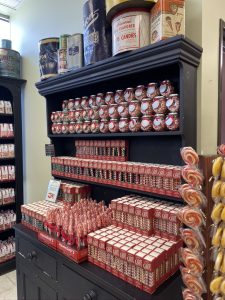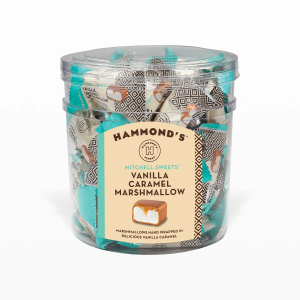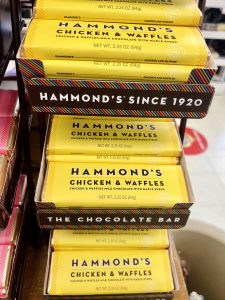Hammond’s Candies
Hammond’s Candies: A taste of tradition
Candy canes, candy corn, candy hearts: whether Christmas or Easter, Halloween or Valentine’s Day, every holiday has its trademark sweet.
When it comes to candy, chocolate reigns supreme. According to the consumer market, the value of the chocolate market in the United States comes close to $50 billion. Sugar confectionery generates only slightly more than $34 billion in market revenue. If you take a tour of Hammond’s Candies Factory in Denver, it is easy to see why you want to spend hours in the retail shop and hand over your wallet for the sweet treats.
Hammond’s Candies sells more than 100 million pieces of candy a year. What makes Hammond’s so sweet? It could be that the company has 100+ year-old recipes from the time it was started in 1920 by Carl T. Hammond, Sr. After returning from World War I, Carl proudly opened Hammond’s Candy Company on the Platte River and operated under the slogan “Nothing is more important than quality,” which helped keep the candy store open during the Great Depression.

While the reins continued being passed down through generations of the Hammond family, in 1995 it was Williams-Sonoma’s order of hand-pulled lollipops, chocolate-covered toffee and peppermint pillows that introduced the local treasure as a national household name.
Located at Washington and 58th Avenue, the massive 35,000-square foot facility is the third location and houses a factory that cranks out four to six batches of candy a day. Each batch is at least 1,000 lollipops and 700 candy canes, using 2,500 pounds of sugar daily. That is how Hammond’s became synonymous with candy canes and lollipops. With over 300 employees, more than 10 million candy canes are hand crafted locally per year at the Denver factory. Hammond’s candy canes are the company’s number one holiday seller. Today, the line has expanded to more than 30 flavors including an all-natural line, a chocolate filled line, classic flavors like peppermint, and fun flavors like very berry.

Surprisingly, Hammond’s supplies its trademark chocolates to other candy stores and retail shops. For example, some of the chocolate sold as Trader Joe’s is from Hammond’s. Retailer See’s Candies orders candies and chocolate from Hammond’s as well. Hammond’s has expanded sales to national brands like Sur La Table, Vermont Country Store, Dylan’s Candy Bar and Harry & David. Hammond’s chocolate factory is in California which produces up to 27 different types of chocolate and Mitchell Sweets.

The Mitchell Sweet, one of its key products, got its name from a good friend of the Hammond’s family. Mitchell came in daily for his favorite caramel marshmallow sweet. Making this ever-popular candy is a labor-intensive, three-day process. The artisan confectioners must first handcraft the marshmallow and allow it to setup overnight. The fluffy marshmallow is then cut into long strips on the second day and dipped into freshly made caramel. On the third day, it is cut into rectangles and individually wrapped in wax paper to become the finished product found in the shop.
Another popular key product is the ribbon candy. Unlike other hard candy production, ribbon candy is made in smaller batches. About 55 pounds are stretched out by hand into thin flat strips. While the candy is still warm, the strips are cut to size and hand-cranked through a crimper to give them their signature look. Ribbon candy is traditionally seen around Christmas time, but due to its popularity, Hammond’s offers it year-round in a variety of flavors.
In 2007, candy lover and entrepreneur Andrew Schuman (pictured lower right), bought Hammond’s Candies and also acquired Old Dominion Peanut Company in Norfolk, Virginia, renowned for its brittle recipes. Under Andrew’s management as CEO, Hammond’s Candies expanded to offer more than candy. It now offers snacks as well as Mellow Fluffs, snackable marshmallows in flavors such as vanilla bean, cinnamon churros, peppermint chip, toasted coconut, maple and strawberry crème. Locally, Tony’s Meats & Market is a favorite supplier of Hammond’s treats. Orders come in daily from Whole Foods, Nordstrom and Cracker Barrel, as well as local and regional specialty shops across the world. The famous Hammond’s candy canes can be found in Canada, England, France, Italy, Spain, Dubai, Kuwait, Japan, Korea and Israel.
“At Hammond’s, we pride ourselves on our rich history and dedication to quality,” stated Schuman. “Each piece of candy represents not just a treat, but a piece of our heart and heritage. We’re committed to maintaining the hand-crafted techniques that have delighted generations, ensuring that each visit and every candy is a special experience for our customers.”

The Hammond’s retail shop is a smorgasbord of treats and snacks from flavored popcorn and handcrafted signature taffy to more than 30 flavors of jellybeans, from Mitchell Sweets to the chocolate bars with specialty flavors such as Bourbon Pecan Pie, Espresso Martini, Chicken & Waffles, PB & J Sandwich, and Pigs N’ Taters – which is milk chocolate with imitation bacon and potato chips.
Customers can grab “oopsies” marshmallows and candy canes – ones that did not pass the quality control cut but are still delicious and edible – for a fraction of retail price.
While the company continues to grow, Hammond’s keeps and maintains its small-batch environment to ensure hand-crafted quality. Customers can tour the factory and see the inner makings of how sugar becomes a favorite treat. Hammond’s welcomes more than 100,000 visitors a year to its factory. To learn more or to book a factory tour, visit www.hammondscandies.com.
Hammond’s Candies: 5735 Washington St, Denver, CO 80216
(303) 333-5588, www.hammondscandies.com
By ViVi Somphon